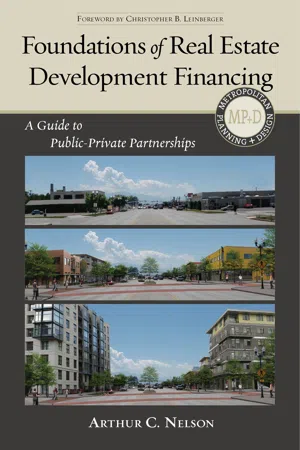
Foundations of Real Estate Development Financing
A Guide to Public-Private Partnerships
- 200 pages
- English
- ePUB (mobile friendly)
- Available on iOS & Android
Foundations of Real Estate Development Financing
A Guide to Public-Private Partnerships
About This Book
America's landscape is undergoing a profound transformation as demand grows for a different kind of American Dream--smaller homes on smaller lots, multifamily options, and walkable neighborhoods. This trend presents a tremendous opportunity to reinvent our urban and suburban areas. But in a time of fiscal austerity, how do we finance redevelopment needs? In Foundations of Real Estate Development Finance: A Guide for Public-Private Partnerships, urban scholar Arthur C. Nelson argues that efficient redevelopment depends on the ability to leverage resources through partnerships. Public-private partnerships are increasingly important in reducing the complexity and lowering the risk of redevelopment projects. Although planners are an integral part of creating these partnerships, their training does generally not include real-estate financing, which presents challenges and imbalances in public-private partnership.This is the first primer on financing urban redevelopment written for practicing planners and public administrators. In easy-to-understand language, it will inform readers of the natural cycle of urban development, explain how to overcome barriers to efficient redevelopment, what it takes for the private sector to justify its redevelopment investments, and the role of public and nonprofit sectors to leverage private sector redevelopment where the market does not generate sufficient rates of return.This is a must read for practicing planners and planning students, economic development officials, public administrators, and others who need to understand how to leverage public and non-profit resources to leverage private funds for redevelopment.
Frequently asked questions
Information
Chapter 1
The Cycle of Development, Optimal Redevelopment, Redevelopment Goals and Benefits, and Barriers to Redevelopment
The Cycle of Development


Optimal Redevelopment
Table of contents
- Cover
- Contents
- Foreword
- Preface
- Acknowledgments
- Introduction: The Future of America Is Redevelopment, and the Future of Redevelopment Is Public-Private Partnerships
- Chapter 1: The Cycle of Development, Optimal Redevelopment, Redevelopment Goals and Benefits, and Barriers to Redevelopment
- Chapter 2: Implementation of Redevelopment Plans and the Role of Public-Private Partnerships
- Chapter 3: Real Estate Finance and Development Basics
- Chapter 4: Survey of Public-Private Partnership Tools and the Role of Public Patient Equity to Leverage Private Real Estate Development
- Conclusion: America’s Progress Depends on Redevelopment through Public-Private Partnerships
- Appendix A: Workbook User Guide
- Appendix B: Simplified Depreciation Periods for Land Uses
- Notes
- References
- Index